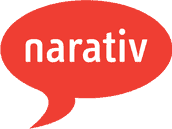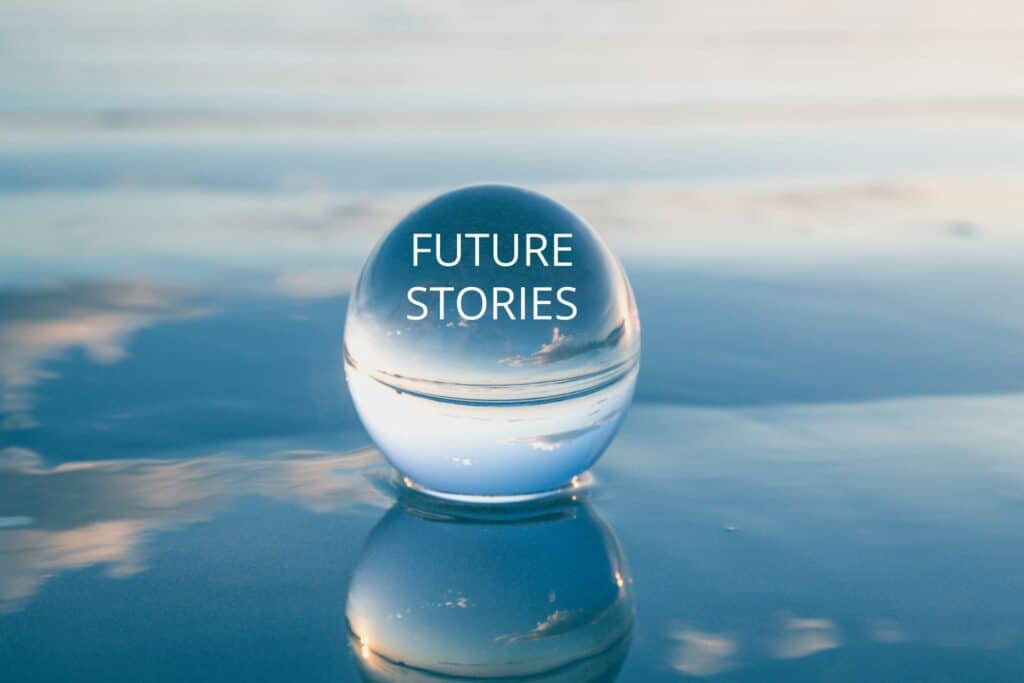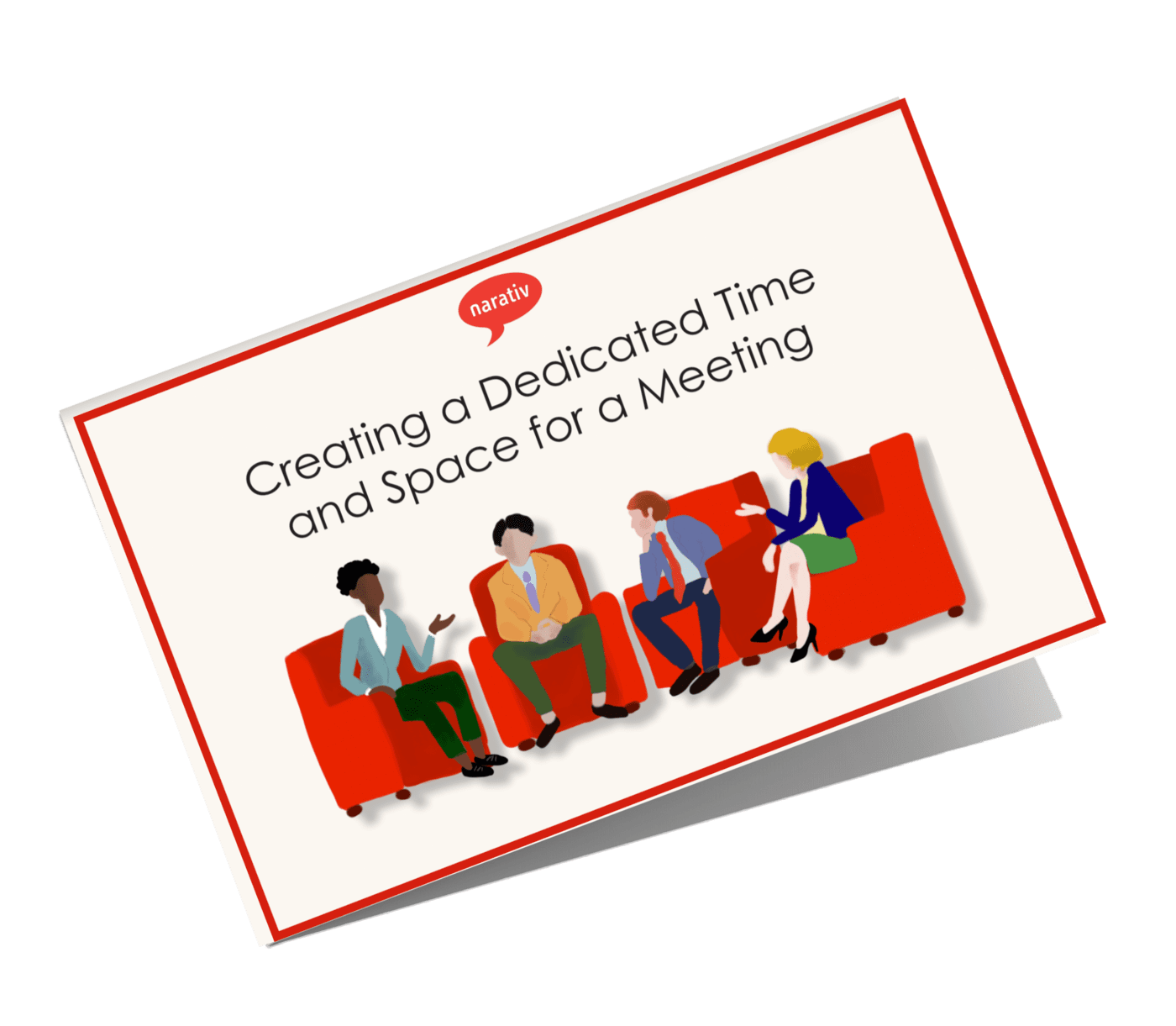Most people in business, leaders especially, at one time or another wish they had the ability to look into the future to ensure their time and efforts are being well placed. Unfortunately, I haven’t yet learned the secret to becoming a business soothsayer. However, I do know how to use future stories to get you pretty darn close—and I’m excited to share this superpower with you today.
Future stories are a way of visualizing future goals for a company that helps you and your team make them happen; a narrative vision board, so to speak. Still not sure what I mean? Let’s take a quick look at how telling stories about the future can help a business team accomplish its goals and bring about its ideal future, all while strengthening the team as a whole.
What are Future Stories, and How Will They Help my Team?
A future story is one that recounts future events as if they have already happened. When you tell a story about something that happened to you, you go into the details of something that occurred in the past. When you tell a future story, you apply the same principle of taking someone through the experience that WILL be had: specific details are given about the events that will transpire and some of the steps taken to get there as well as the problems that were encountered and overcome along the way.
Imagine getting ready to tell your team about your 1-year strategy for 2023: What if you started by saying “It’s June 2023, and I receive a phone call from the CEO, telling me that my team achieved its revenue goal.” And then you can go back from that future point and tell the story of how your team achieved these outcomes.
This is an excellent exercise for taking a close look at your goals and assessing how they can realistically be achieved. Not only that, it’s a way for every member of your team to get clear on the “why” of your organization and align their personal values with those of their team and the company as a whole.
The process of creating future stories is, by necessity, a collaborative effort because it requires listening and working together to create a unified vision of where you want to go as a team. That kind of focused synergy alone would be an ideal takeaway from any team-building exercise, but this exercise takes it one step further—laying out a vision for the future in such specific terms is the perfect way to get everybody in the mindset of working toward the same concrete goal.
The Story of the Future, Told in a Day
As somebody who teaches storytelling for a living, it’s always exciting for me to watch a group break through their own mental barriers to deliver on the assignment. (I recently had this opportunity at a workshop I facilitated—more on this below!) The great news is that this process isn’t as daunting as it seems. It can easily be undertaken by any team that wants to become clearer and more unified about the future. The trick is breaking it up into manageable stages.
Stage 1: Excavate the “why”
How many of us can honestly say we have a full understanding of the goals and motivations of the company we work for? Most of us aren’t even sure about our own motivations for what we do half the time. This is why understanding the “why” is your first step on the road to clarity.
As a group, have your team identify the core mission of the company so the vision is clear to everyone present. Any company with staying power has a mission beyond profit, and getting your team clear about what that vision is will make it a lot easier for them to figure out how their personal values align with the company’s—or how they can use their role to bring the company more in line with their own driving values.
For a little more help with this process, I’ll point you to the fantastic TEDx video featuring Simon Sinek: Start with why — how great leaders inspire action. This is a great resource for understanding and identifying the motivating factors behind your organization.
Stage 2: Lay the foundation with individual future stories
The next stage focuses on laying the foundation for connecting the organizational “why” with the people who will carry it out. Have your team break off into groups of two or three and take turns telling individual future stories. They should begin the story by establishing the date (ex: “It’s June 20, 2024, and I’m…” ) and focus on how their values and impact can contribute to the future of the organization.
For example, at that future stories workshop I mentioned above, one of the participants chose to focus largely on his daughter’s passion for clearing the ocean of plastics and how his own desire to make her proud had led him to discover that the company he worked for was already using ocean-safe packaging for its products. This gave him a sense of value alignment upon which he could base his story. He began his story like this: “It’s May 2023 in a nice restaurant in San Francisco. There are lots of beautiful flowers and great Vietnamese food. I will have a big celebration for my daughter Gina for her offer acceptance to work for a new company.”
After the members of each group have shared their personal future stories, have them work together to combine their stories into a collaborative 4-minute future story. Once everyone’s ready, have each story presented to the larger group by a nominee from each group.
Stage 3: Identify the gaps
After each group presents their combined story, ask the listeners to reflect and give feedback on what they heard. They should particularly focus on the gaps between the future vision and present-day reality, and then discuss what is missing that the team at large will need to reach the stated goal as well as what is already being done by the team or company to get there.
Something wonderful I noticed during this recent workshop was that not only did teammates use this time to find those gaps, but many of them also took the time to uplift the presenter, praising them for the confidence and conviction with which they shared their visions—including the ways that the story spoke to their own passions.
During the discussion, have your group talk about what was inspiring about the story they just heard. Which details really got them excited about making this future real? What got their brain juices flowing with ideas for bridging the gaps?
This group discussion is integral to putting the envisioned future on the path to becoming reality. Vision solidifies so that it can start to become action, which leads right into the final stage.
Stage 4: Reveal the “Why” and Create an action plan
Here is where everything comes together to turn stories into functional reality. We started by identifying the organization’s “why” in stage one, and then stages two and three further refined it and brought it into alignment with the values of the people who will be carrying it out. This process naturally spurs changes to the stated “why,” and so it’s not until here at the end that we’ll discover the true “why” of the organization.
And one of the best parts of this exercise is that you will not only reveal the true “why” but you’ll also have already set the groundwork for the group to create an action plan for reaching the goals that were identified!
Now, have your team work together to separate what is doable in the established time frame (we recommend two years) from what is more of an aspirational long-term goal, and then create a timeline for action on the attainable goals. The timeline should be detailed and actionable, clarifying the role every member of the team will need to play to keep things moving forward.
Ideally, with everyone now clear on the mission of the organization, their future goals, and their personal part in the process, the action plan will organically take form. By the end, people are usually reveling in their collective discoveries, excited to set the plan in motion so that they can see their visions come to pass.
Writing the Future Writes the Present
Now that we’ve been through all four stages of the future story exercise, I hope you can see that the outright goal of this exercise is not the timeline itself—though getting the future on track is a great added benefit. What we’re really going for is the clarity of purpose your team members will achieve through participating. In the end, it is more about the shared experience of the team working in full alignment together than meeting the exact goals that were laid out because it is the collaboration and connection that ensures a bright future.
If you’d like some help in trying this out with your own team, or if you’d like to learn more about Narativ, please reach out. If you’re interested in more general business storytelling training for your team or organization, you can find out more here.




